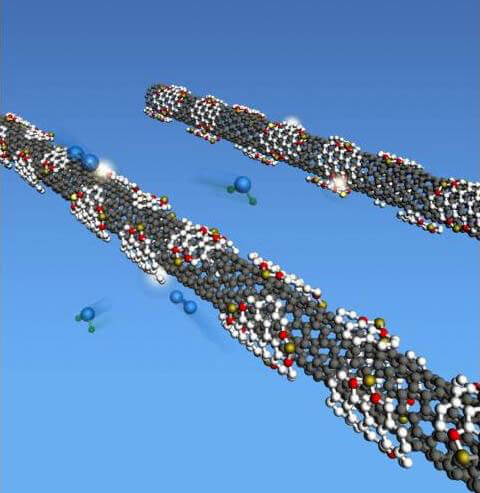Stanford University scientists have found that carbon nanotubes with defects and impurities on their exterior could replace the expensive platinum catalysts used today in fuel cells and metal-air batteries.

Stanford University scientists have found that carbon nanotubes with defects and impurities on their exterior could replace the expensive platinum catalysts used today in fuel cells and metal-air batteries.
"Platinum metal is very expensive and therefore impractical for large-scale commercialization," said Hongjie Dai, a professor of chemistry at Stanford University. "Therefore, the development of a cheap alternative to platinum has been a coveted research goal for decades."
Over the past five years, the price of platinum has risen from eight hundred dollars per ounce (28 grams) to two thousand two hundred dollars per ounce. One of the most promising materials that can be used as a cheap alternative to platinum is carbon nanotubes - a rolled sheet of pure carbon known as graphene, a sheet with a thickness of a single carbon atom. Carbon nanotubes and graphene are excellent electrical conductors and relatively cheap to manufacture.
In this study, the scientists used multi-walled carbon nanotubes containing two or three tubes placed inside each other. The researchers showed that tearing the outer wall while leaving the inner walls intact increases the catalytic activity in the nanotubes and still does not interfere with their ability to conduct electricity.
"Carbon nanotubes usually have several defects," explains one of the researchers. "However, the defects are actually important for encouraging the formation of catalysis sites and maintaining the ability of the nanotubes to remain active for catalytic reactions."
The researchers inserted their nanotubes into the solution. Microscopic examination revealed that the solution caused the partial priming of the outer nanotube and the formation of nanoscale graphene particles that adhered to the inner nanotubes. "We discovered that adding a few iron and nitrogen impurities makes the outer wall very active in terms of catalytic reactions," explains the lead researcher. "At the same time, the interior of the nanotubes remains intact and provides a pathway for the movement of electrons. You want the outer side to be very active and still for the material to have good electrical conductivity. If we use carbon nanotubes with only one wall, we will not be able to get this advantage since the destruction of the wall will eliminate the material's ability to conduct electricity."
In fuel cells and metal-air batteries, the platinum catalyst plays a vital role in accelerating the chemical reactions that convert hydrogen and oxygen to water. However, it is also possible that the multi-walled nanotubes and partially hollow ones will work this way, the researcher added. "We discovered that the catalytic activity of the nanotubes is very close to that of platinum," said the researcher. "This high activity and the stability of its design make this material a promising candidate in the application of fuel cells." These nanotubes could also be used in metal-air batteries composed of lithium or zinc.

One response
Do pipes conduct electricity and a mirror conducts heat